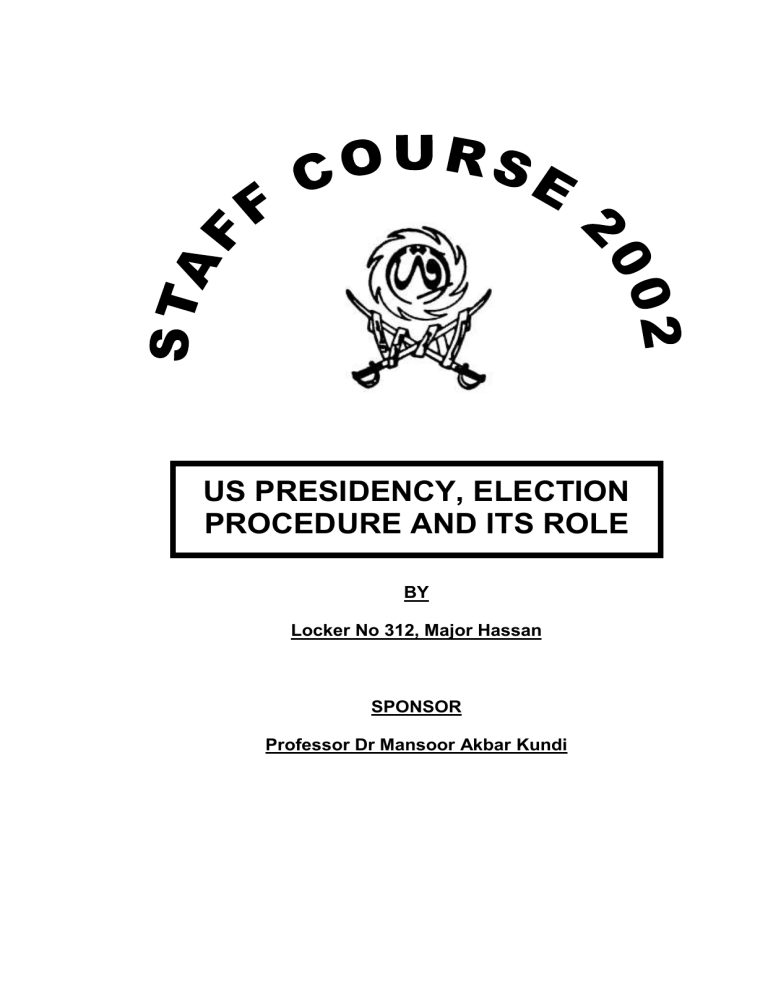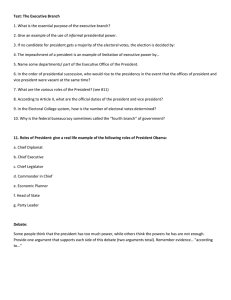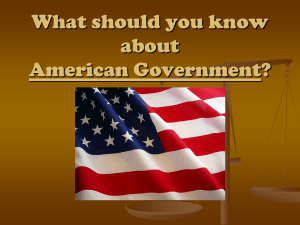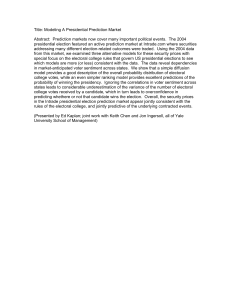312-Hassan-US Presidency, Election procedure and Its Role
advertisement

US PRESIDENCY, ELECTION PROCEDURE AND ITS ROLE BY Locker No 312, Major Hassan SPONSOR Professor Dr Mansoor Akbar Kundi 1 US PRESIDENCY, ELECTION PROCEDURE AND ITS ROLE 1. Introduction. United States is an established democracy with functional constitution since 1789. It has matured over time and is considered a symbol for other countries. It is a Presidential System in which US President has most of the powers but there is a system of check and balances between US President, House of Representatives, Senate and US Supreme Court. 2. Aim. To study and analyse election of US President and his role in Political System. 3. Historical Perspective. 1The founding fathers of United States met in Philadelphia to write the legendary US Constitution in 1787. In creating the constitution they recognised that they were designing the rules that would govern how future political game would be played. The delegates to the 1787 Philadelphia Convention, who framed the U.S. Constitution, brought with them various conceptions of executive power. Three questions dominated the framers' consideration of the role the executive would play in the new government. First, the delegates discussed whether the executive should be a single individual or whether multiple persons should share the office. Second, they considered at length the amount of power the executive should wield. And third, they debated the best means by which to elect the executive. Generally, deliberations on these questions involved the balance of power in the new government. The framers feared that a powerful executive could usurp legislative authority and engage in tyrannical actions. The weak executives created by the state constitutions, however, proved unable to prevent state legislatures from trampling on the people's rights. The founding fathers sought to create a government in which, as James Madison explained in FEDERALIST 51, "Ambition must be made to counteract ambition." Madison deemed a balance of power necessary, and he called for a governmental arrangement in which it would be in the best interest of all citizens to resist executive encroachment. Although they recognized the importance of strong leadership, Americans feared executive tyranny. To guard against the creation of an authoritarian monarchy, many delegates called for a plural executive. Advocates of a plural executive believed that vesting presidential power in more than one man 1 Stephen E. Frantzitch and Stephen L. Percy, American Government. (Brown and Benchmark Publishers, 1994), P. 23. 2 would lessen the danger that leaders would abuse power. When the Pennsylvania delegate James Wilson moved on June 1, 1787 that the executive should consist of one person, a lengthy silence ensued. The framers eventually decided upon a single executive. They decided this on the basis that conflicts would be more easily avoided if there were only one executive. Also, they believed that Congress could more carefully watch and check a single executive. The length of the president's term and the method of election were also contested issues. The delegates initially agreed that the president would serve a seven-year term and would be ineligible for re-election. After much debate, they decided a bicameral Congress would elect the executive. On July 26, the Convention presented its decisions to the Committee of Detail, which was charged with the task of organizing the resolutions into a constitutional draft. Of the five members of the Committee of Detail, only Nathaniel Gorham advocated executive authority. As a result, the Committee's draft of the description of the executive provided the office with scant power. In late August, as the Committee of the Whole reconvened to examine the Committee of Detail's draft, the proposed presidency consisted of the following:a. There would be a single president elected for a seven-year term by a joint session of Congress. b. The president would be ineligible for re-election, would have no power of appointment or removal, and could be impeached by the House and convicted by the Supreme Court. c. The president would be commander-in-chief, would possess a conditional veto over Congressional legislation, and could grant pardons and reprieves. d. In the final days of the Convention, several adjustments were made in these provisions and the executive office evolved into its current form. e. The president's enumerated powers as listed in Article II of the Constitution included commander-in-chief of the armed forces, the authority to grant pardons and reprieves, the ability to veto legislation, the power to make treaties with other nations, and the power to appoint judges, executive department heads, and ambassadors. f. To ensure a balance of power, the legislative and executive branches had the ability to check presidential actions. For example, only Congress could declare war, two-thirds of both Congressional houses 3 could override a presidential veto, the Senate must confirm all treaties made by the president, and the Senate must approve presidential appointments. The House could impeach the president with the Senate serving as judge or court. The framers hoped this system of checks and balances would prevent the reign of a tyrannical executive. In addition to finalizing the executive's power, the framers discussed methods of selecting the president. Lacking trust in the people's ability to elect the president directly and hesitating to allow existing legislative bodies to select the president, they designed the Electoral College. 4. Election of US President a. Eligibility. 2Only a natural-born citizen is eligible to serve as President of the United States. He or she must be at least 35 years old and must have been a 14 year resident in the United States prior to running for office. So far the United States has never had a female President or Vice President. As of the year 2001, the United States has had 43 presidents since 1789; this number includes the current President-Elect George W. Bush who took office on 20th of January 2001. b. Campaigning. 3Campaigning usually begins the year before a Presidential election, but gets in to full swing after Labour Day the year of the election. The candidates travel throughout the country often speaking several times a day sometimes to greet crowds and consult with various party leaders to gain support. Campaigns whip up enthusiasm among supports and help bring voters to the polls. The national conventions are held in the summer before a Presidential election. Delegates from all the states, the District of Columbia, and the United States possessions choose the party candidate for President by majority vote, normally through state-to-state primaries elections. 2 How The President of the United States http://homepages.rootsweb.com/~afreeman/election.htm. 3 ibid. Is Elected [Online] Available 4 c. Election Methodology. 4The Presidential election is held on the Tuesday after the first Monday of November in years divisible by four. Voters do not vote directly for the President, but instead select Presidential Electors. 5Each state is assigned a number of electors in the Electoral College equal to the number of members of the House of Representatives from that State plus the State’s two senators. 6Voters choose a body of electors who run in the name of the Presidential and Vice Presidential candidates of their party and are pledged to cast their state's electoral votes for these candidates. The outcome is usually known immediately after the popular votes are counted, but the election is not officially settled until the electoral votes are cast and counted in early January following the election year. If no candidate receives the majority of electoral votes, the House of Representatives chooses the President from the three with the highest number of electoral votes. The balloting is by state, each state having one vote. The electors meet in their state capitals on the first Monday after the second Wednesday in December following their election. Sealed certificates of the electoral vote of each state are then sent to Washington D.C. On the sixth day of January the votes of the electors of all the states are opened in the presence of both Houses of Congress. After the votes are counted, the result of the election of the President and Vice President is officially announced. The President of the United States is inaugurated on the 20th of January of the year following the election. The ceremony occurs on the steps of the capitol. The oath of office is administered by the current Chief of Justice of the United States. d. Other facts. 7The President is the chief executive officer of the United States national government. He is both head of state and head of government. This is similar to having powers of a king and a prime minister, in comparison to other republics. His salary was about 4 ibid. Stephen E. Frantzitch and Stephen L. Percy, American Government. (Brown and Benchmark Publishers, 1994), P. 285. 6 How The President of the United States Is Elected [Online] Available http://homepages.rootsweb.com/~afreeman/election.htm. 7 ibid. 5 5 $200,000 a year with $50,000 a year for expenses; both taxable. Presidents may obtain not more than $100,000, non-taxable, for travel and entertainment expenses. (A President receives a lifetime pension of $60,000, plus free mailing privileges, free office space, and up to $90,000 a year for office help. His widow receives $20,000 a year for office help). President George Bush will receive $400,000 a year, due to a bill passed while President Clinton was in office. The President of the United States then serves a four year term as defined by the Constitution of the United States (Article II, Sec. 1). He or she may then campaign and run again. If elected again, they will serve another four years. A President can serve only two terms. They do not have to be consecutive, as in the case of the 22nd & 24th President Grover Cleveland, but usually have been. However, Franklin D. Roosevelt served four terms, but died before fourth term was up. The 22nd Amendment of the Constitution, adopted in 1951, provides than no one can be elected President more than twice. 5. Role of President in US Politics a. 8The Constitution of the United States gives the president enormous power. However, it also limits that power. The authors of the Constitution wanted a strong leader as president, but they did not want an all-powerful king. As a result, they divided the powers of the United States government among three branches executive, legislative, and judicial. The president, who is often called the chief executive, heads the executive branch. Congress represents the legislative branch. The Supreme Court of the United States and other federal courts make up the judicial branch. Congress and the Supreme Court may prevent or end any presidential action that exceeds the limits of the president's powers and trespasses on their authority. The president has many roles and performs many duties. 9Specifically, the Constitution assigns following powers to the President:8 The Office of the President http://www2.worldbook.com/features/presidents/html/officepres.htm. 9 The President of the United State [Online] Available 12/government/national/president.html. [Online] Available http://bensguide.gpo.gov/9- 6 (1) Commander in Chief of the Armed Forces. (2) Make treaties, with two-thirds consent of the Senate. (3) Receive ambassadors and other public ministers from foreign countries. (4) Appoint ambassadors, Supreme Court justices, federal judges, and any officials as provided for by the Congress, with the approval of the Senate. (5) Give an annual State of the Union Address to Congress. (6) Recommend legislation to Congress. (7) Convene Congress on extraordinary occasions. (8) Adjourn Congress, in cases of a disagreement about adjournment. (9) "Take care that the laws be faithfully executed". (10) Fill in administrative vacancies during Congressional recesses. (11) Grant reprieves and pardons for offences against the US. (12) For convenience, we have divided these main powers into three categories: Head of State, Administrative, and Legislative Powers. b. 10As Head of State, the President meets with the leaders of other countries. He has the power to recognize those lands as official countries and to make treaties with them. However, the Senate must approve any treaty before it becomes official. The President also has the power to appoint ambassadors to other countries, with the Senate’s approval. The President is also the official head of the U.S. military. As Commander in Chief, he can authorize the use of troops overseas without declaring war. To declare war officially, though, he must get the approval of the Congress. The President’s administrative duties include appointing the heads of each Executive Branch department. Of course, these appointments are subject to the approval of the Senate. The President also has the power to request the written opinion of the head of each Executive Branch department, regarding any subject relating to their department. 10 ibid. 7 6. Procedure for Impeachment of President of United States. 11The writers of the U.S. Constitution adopted the British procedure with modifications primarily designed to discourage the practice (then common in England) of using impeachment as an instrument of political warfare. Six clauses in the federal Constitution embody the law: Article I, sections 2 and 3; Article II, sections 2 and 4. The House indicts, the Senate tries, and the chief justice of the United States presides over the inquiry in case of impeachment of the president. Traditionally, the House, after drawing up and voting on articles of impeachment that specify the charges and their factual bases, assigns congressional "managers" (prosecutors) to present the case before the Senate. At the start of the trial, the members of the Senate are sworn in as "jurors" by the chief justice. A two-thirds vote of the senators present is required to convict. Punishment is limited to removal from office, though disqualification from future office is considered to fall within the discretion of the Senate, and the acts of the accused are still subject to criminal proceedings in the courts. Impeachable acts are "Treason, Bribery, or other high Crimes and Misdemeanours." The presidential power to grant pardons does not extend to impeached persons. One of the most vexing questions raised by these provisions is what are high crimes and misdemeanours?" Few have questioned that the actions attributed to Pres. Richard Nixon during the Watergate affair were sufficiently criminal to warrant impeachment. But citizens and experts alike questioned the impeachment in 1998 of Pres. Bill Clinton for lying about an illicit sexual affair, which many considered to have little or no bearing on the president's ability to conduct his office. The conclusion reached by most scholars is that clear criminal law violations represent impeachable offences, whereas misconduct that is not necessarily criminal but that undermines the integrity of the office (such as disregard of constitutional responsibilities) may rise to the level of an impeachable offence. Partly because of this and other ambiguities, and partly because the trial stands to tie up the Senate for a considerable length of time, impeachment has taken place infrequently at the national level. Repeated attempts in Congress to simplify impeachment or to establish a special court for the removal of judges have fallen before the enduring conviction that the present procedure, however cumbersome, is a necessary element of the system of checks and balances. By 11 The American presidency http://gi.grolier.com/presidents/ea/side/impeach.html. [Online] Available 8 making impeachment difficult, the Constitution guards against the intrusion of the legislature into the business of the judiciary and executive branches. It also ensures that impeachment remains primarily a legal, or judicial, procedure rather than a political process. Attempts have been made to impeach a number of presidents, but only Andrew Johnson, Richard Nixon, and Bill Clinton were in real danger of being removed from office. 7. Analysis of US Presidential Election and Presidency a. US Presidential system is a very good federal system with appropriate check and balance between the powers of all three pillars of state i.e. executive, legislature and judiciary. b. 12The Electoral system of counting votes in which the candidate winning the majority of popular vote in a state wins all the electors encourages Presidential Candidates to focus their campaign effort on the politically competitive states with the largest number of electoral votes. Thus advertising campaign and candidates visits emphasis major urban areas of large population states where the candidate can see a lot of voters and capture the attention of both local and national media. The winner takes all nature of the Electoral College encourage both the voters and issues of those states they have either little chance of winning or losing. c. The Electoral system of counting votes means that popular vote of people is not truly respected e.g. a candidate winning 49% of valid votes in a state does not get even a single elector vote in that state. Hence 49% valid voters are denied any participation in the election of President. The whole system of Presidential Election is quite undemocratic as 2000 Elections brought out that Democrat Candidate Al Gore was defeated despite winning more overall popular votes. d. Electors selected through Presidential Election elects the President. Electoral College elects are not bound to vote for popular vote. e. US President enjoys overwhelming powers which if given to a realist person like George W. Bush could destabilise the whole world. 12 Stephen E. Frantzitch and Stephen L. Percy, American Government. (Brown and Benchmark Publishers, 1994), P. 368. 9 f. The growing cost of Presidential Campaign forces Presidential Candidates to look for donations from individuals and organisations. These contributing organisations can have a motive for financing which they would pursue in case of success of their sponsored candidate which could become harmful for democracy. Influence of Jewish organisations in United States is a typical case in point. g. Despite propagating the trumpet of equality no women has ever been elected as President of United States. 13The Equal Rights Amendment (ERA) is an example of a proposed constitutional amendment which was approved by both houses of Congress but failed to obtain approval at the states’ level. h. 14 Despite the American commitment to equality, the presidential selection process takes place on an uneven playing field that historically deals out many more potential players that it includes which is a clear case of discrimination. 8. Conclusion. The presidential selection process shapes the nature of Presidency it spawns by determining the incoming leader and the nature of the team he brings into the White House. Constitutional requirements and public preferences limit the bench of potential players to a relatively restricted set of contenders. Presidents are human being who bring with them a series of past behaviour patterns and personal goals that affect the way in which they view and carryout their duties. Presidents set the tone of their administrations and establish key policy priorities. Success or failure is marked to a large degree by the President’s skill and willingness to go beyond the strict constitutional definition of the President as an administrator and enter the political battle. 13 Stephen E. Frantzitch and Stephen L. Percy, American Government. (Brown and Benchmark Publishers, 1994), P. 48. 14 ibid, P. 365. 10 BIBLIOGRAPHY Books 1. Stephen E. Frantzitch and Stephen L. Percy, American Government, Brown and Benchmark Publishers, 1994. Internet 2. How The President of the United States Is Elected [Online] Available http://homepages.rootsweb.com/~afreeman/election.htm 3. The Office of the President [Online] Available http://www2.worldbook.com/features/presidents/html/officepres.htm 4. The President of the United State [Online] Available http://bensguide.gpo.gov/9- 12/government/national/president.html 5. The American presidency http://gi.grolier.com/presidents/ea/side/impeach.html [Online] Available



